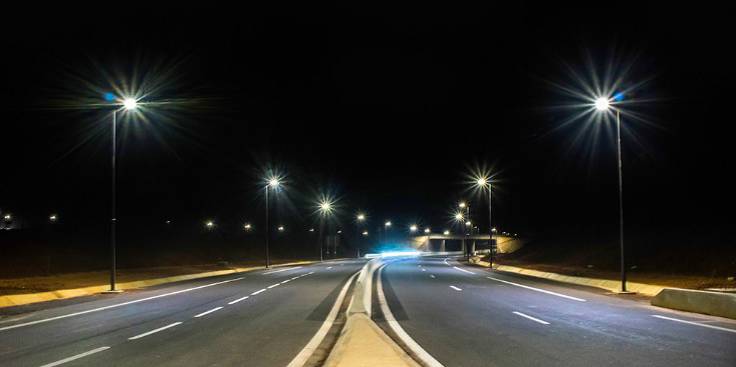Lack of natural light during nighttime in the urban environment was always a problem. From basic inconvenience that people cannot see where they are going to the greater chance of being attacked or mugged during the night. Because the problem was there since humans started living together, history of street light is maybe longer than we think.
1 What is street light?
A street light or street lamp is a raised source of light often mounted on a lamp column or pole either on the side of the road or within the median, or suspended on a wire above the road to provide illumination. Street lighting can provide safety benefits at midblock and intersection locations and can also improve safety for pedestrians, particularly at crossing points.
2 60-second history of street lights:
As many as 55 million streetlights illuminate American roadways today, lighting a path for more than 250 million cars and trucks . But streetlights predate the earliest cars by thousands of years. From ancient oil lamps to advanced LEDs, following is a 60-second history of streetlights.
In ancient Rome, wealthy citizens used vegetable oil lamps to light the front of their homes. Special slaves were responsible for lighting, extinguishing and watching the lamps.
In 1417, the Mayor of London ordered that all homes must hang lanterns outdoors after nightfall during the winter months. This marked the first organized public street lighting.
Scottish inventor William Murdoch kicked off a movement toward more efficient street lighting in 1802. His coal-fueled gas light illuminated the outside of the SoHo Foundry for a public presentation. Five years later, London had its first gas-lit street.
In 1816, Baltimore became the first U.S. city to install gas streetlights. Paris followed closely behind, in 1820. These early gas lights consisted of gas lanterns placed on poles.
Paris laid claim to the world’s first electric streetlights. Its arc lamps, also known as Yablochkov candles, were installed in 1878. Three years later, 4,000 of these electric lamps were in use, effectively replacing gas lanterns mounted on poles.
Thomas Edison changed the world when he determined how to create a pure vacuum in his bulbs – something Joseph Swan was unable to achieve. Edison’s carbon-thread incandescent lamp, introduced in 1879, led to the development of light bulbs for streetlights.
Low-pressure sodium lamps were introduced in Europe in the 1930s. These lamps included a removable outer jacket and a vacuum layer for insulation, maintaining a high temperature to keep the sodium in vapor form.
American Nick Holonyak, Jr. developed the first practical visible spectrum light-emitting diode (LED) in 1962.
In 1965, high-pressure sodium (HID) lamps brought superior color and efficiency compared to their low-pressure predecessors. HID lamps are still the most widespread type of streetlight on the planet.
Modern LEDs last longer, produce better light and use less energy than HID lamps. While LEDs represented a tiny fraction of streetlights in the U.S. a few years ago, the pace of adoption is growing by leaps and bounds.
We’ve come a long way since the days of the ancient Romans. And, thanks to the rapid rise of LEDs, HID streetlights may soon be just as extinct as the oil lamps the Romans used to light long-vanished roads.
3 Modern street lights:
Today, street lighting commonly uses high-intensity discharge lamps. Low-pressure sodium lamps became commonplace after World War II for their low power consumption and long life. Late in the 20th century HPS high pressure sodium lamps were preferred, taking further the same virtues. Such lamps provide the greatest amount of photopic illumination for the least consumption of electricity.
However, white light sources have been shown to double driver peripheral vision and improve driver brake reaction time by at least 25%; to enable pedestrians to better detect pavement trip hazards,and to facilitate visual appraisals of other people associated with interpersonal judgements. Studies comparing metal halide and high-pressure sodium lamps have shown that at equal photopic light levels, a street scene illuminated at night by a metal halide lighting system was reliably seen as brighter and safer than the same scene illuminated by a high pressure sodium system.
Two national standards now allow for variation in illuminance when using lamps of different spectra. In Australia, HPS lamp performance needs to be reduced by a minimum value of 75%. In the UK, illuminances are reduced with higher values S/P ratio.
New street lighting technologies, such as LED or induction lights, emit a white light that provides high levels of scotopic lumens allowing street lights with lower wattages and lower photopic lumens to replace existing street lights. However, there have been no formal specifications written around Photopic/Scotopic adjustments for different types of light sources, causing many municipalities and street departments to hold back on implementation of these new technologies until the standards are updated. Eastbourne in East Sussex UK is currently undergoing a project to see 6000 of its street lights converted to LED and will be closely followed by Hastings in early 2014.
Milan, Italy, is the first major city to have entirely switched to LED lighting.
In North America, the city of Mississauga (Canada) was one of the first and biggest LED conversion projects with over 46,000 lights converted to LED technology between 2012 and 2014. It is also one of the first cities in North America to use Smart City technology to control the lights. DimOnOff, a company based in Quebec City, was chosen as a Smart City partner for this project.
Photovoltaic-powered LED luminaires are gaining wider acceptance. Preliminary field tests show that some LED luminaires are energy-efficient and perform well in testing environments.
In 2007, the Civil Twilight Collective created a variant of the conventional LED streetlight, namely the Lunar-resonant streetlight. These lights increase or decrease the intensity of the streetlight according to the lunar light. This streetlight design thus reduces energy consumption as well as light pollution.
4 Why choose LED street lights?
LEDs will play an increasingly important role in street lights. Why do so many people choose LEDs? Here are 6 benefits:
1 Long lifespan
The average lifetime of LED street lights is mainly 15-20 years which is two to four times longer than normal incandescent bulbs. These bulbs mainly not fail or burn out as compared to other bulbs. They are barring a catastrophic failure of electronic or mechanical components of the LED fixture.
Lifetimes are typically set by decreasing in luminous output of up to 30%. It is important to understand that replace LED or less frequent need to servicing a LED bulbs or lower maintenance cost required.
2 Low energy consumption and high CRI
Mostly LED lights have reduced energy use. They reduce energy consumption up to 30 to 40 percent. Their lower energy using automatically reduce the illumination levels.
Color rendering index is the ability of the light source to correctly reproduce the color of objects as compared to the ideal light source. Improve color rendering also easier for drivers to recognize various potential road hazards.
3 Less glare
These lights are directed on the roads which reduce the amount of light that gets directed into driver’s eyes. LED street lights never in low temperatures. They have better work in the low temperature. LED street lights giving a high light output in the winter season while fluorescent lights have very less output.
4 No refractor required
Mainly street light using a reflector to capture the light emitting upward from the lamp. Even under the various conditions, reflector absorbs much of the light. If we saw fluorescent or phosphor coated bulbs then we realize that bulb itself absorbs light directed back down by the reflector.
Refractor helps the project to lay down on the street in a desired pattern but some light is wasted being directed up to the sky. LED lamp assemblies don’t require any reflectors and can be designed to provide the desired coverage without a refractor.
5 No pollution
LED bulbs don’t use any toxic material like mercury or neon. It doesn’t produce any poisonous gases when it is damaged, therefore, it is much safe. The procedure of On and OFF is much fast.
LED light turns on instantly and doesn’t take to heat and start than any normal incandescent bulbs. Unlike sodium vapor lamps, mercury vapor or metal halide, LED turns on with the only blink of an eye. It attains the 100% light output instantly.
6 Intelligent operation control
Roadway lighting covers a broad range of locations, from low-traffic residential neighborhoods and rural roads to interstate freeway interchanges. All have their own requirements for acceptable light levels and distribution patterns and this is where LED street light systems with “smart control” can be the most effective.
For example, street lights with controls systems offer dynamic dimming during long periods of inactivity, a feature with tremendous potential to save energy, mitigate waste, reduce light pollution, and increase public safety. Or, LED street light systems with embedded sensors can detect movement from pedestrians, cyclists and vehicles, anticipate their approach, and communicate the change in traffic to light poles downstream, increasing light output in a fluid and real-time response to travelers’ needs.










